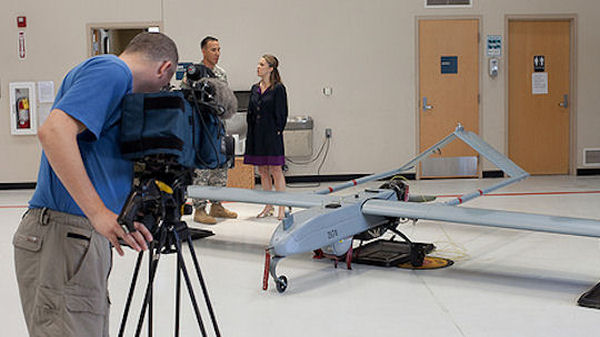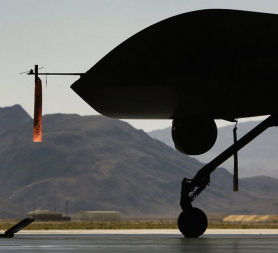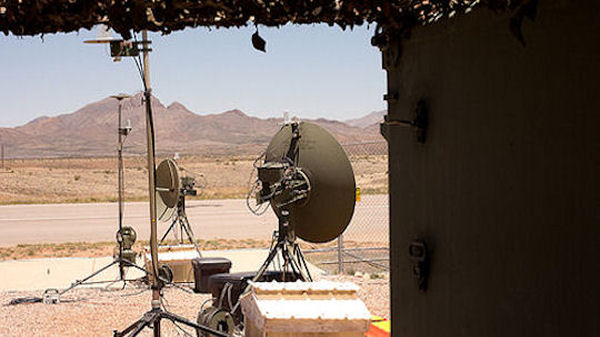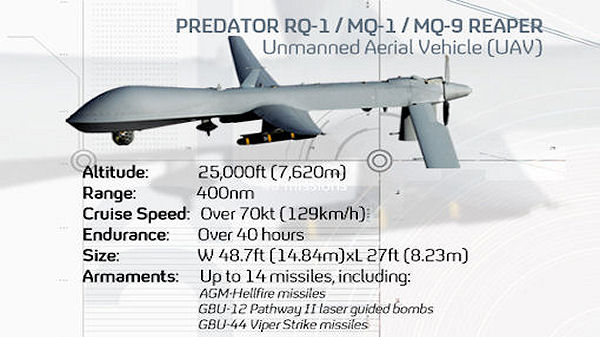US drones: tools of modern warfare
With the UN saying CIA use of drones in Pakistan is “illegal”, Channel 4 News correspondent Sarah Smith visits an army base training soldiers to use them as America’s main weapon against al-Qaida.
At Fort Huachuca (you say it Wa-choo-ka) near the Mexican border in Arizona they let me take the controls in the flight simulator that teaches young soldiers to fly unmanned drones half a world away.
You don’t have to be a qualified fighter jet pilot anymore to be allowed to fly these things – or an officer. Thousands of young enlisted soldiers – many as young as 18 – are being trained to fly these aerial vehicles and the US military just can’t get enough of them.

“Is it a bit like playing a video game?” I asked as I handled the joystick. It is they admitted – although everyone was at pains to stress that doesn’t mean they don’t take their job seriously.
Even the trainer admitted its easier to teach the “video game generation” and told me that all those hours they’d spent in their bedrooms – being nagged by their mothers to do something more productive – was now paying off.
“Is it a bit like playing a video game?”
The US military are now so addicted to the use of these drones they call them “army crack”. One hit and you are hooked they say. Ground forces now don’t want to leave their bases in Iraq and Afghanistan without those “eyes in the sky” above their heads.
UN report says CIA drone strikes in Pakistan 'illegal'
A report, formally submitted to the UN's Human Rights Council in Geneva, says the use of drones to target militants "violate straightforward legal rules".
Click here to view full report
"The refusal by States who conduct targeted killings to provide transparency about their policy violates the international framework that limits the unlawful use of legal force against individuals. A lack of disclosure gives States a virtual and impermissible licence to kill."
The report is a blow to the US government which has ramped up covert drone attacks in Pakistan. This year alone, more than 134 such attacks have taken place, a huge increase which has been sanctioned by President Barack Obama.
The US government will not say how many innocent civilians have been killed in Pakistan, but estimates range from 30 to over 300. The attacks have mostly taken place in remote tribal regions, where there is little manpower on the ground and investigations into whether the correct targets were hit are hard to undertake.
The report says any drone strikes carried out by the US military in Pakistan or elsewhere should be carried out by uniformed military personel, to whom the laws of war are more rigorously applied.

One young soldier told me about a combat mission he flew in Iraq. Although he was in a control station inside a little trailer hundreds of miles from the battle, via his Hunter drone, he could see far more clearly what was going on than the marines who were on the ground.
As they made their way into a graveyard Staff Sgt Salvador could see insurgents who were hiding out there ready to ambush the Americans. He was able to describe to the ground forces that there was gunman hiding behind a tan coloured building 50 meters to their north, another hiding behind a low wall 50 meters to their west. They shot straight through the walls. At targets they couldn’t actually see. And Salvador could tell them when they’d killed the Iraqis.
The aerial technology the US uses is sophisticated and expensive. But the principle is not dissimilar to remote controlled toy planes. And it’s becoming quite easy to copy.
The editor of Wired magazine built his very own drone in his garage for just $1,000. And it’s known that various terror groups are already trying to do the same thing.
Experts warn that terrorists have realised there is no better way to deliver a radioactive, chemical or biological weapon into the heart of a city like London or New York.
Several of the people recently arrested in America for attempted terrorist attacks on New York – both the man who left a car bomb in Times Square and the one who was planning to bomb the subway – say they were inspired by wanting to retaliate against US drone attacks in Pakistan.

As the US army were proudly showing off their technology to me no one seemed worried about the idea that similar kit could be used against them.
“What terrorist is going to have a Predator?” scoffed an official from the Dept of Homeland Security recently.
Well, Hezbollah have them already and have flown them over Israel. And it is notable that China has developed its own version of the Predator – the Pterodactyl. And Iran is currently building surveillance drones that they could attach weapons to.
Right now the American drones are al-Qaida’s biggest enemy. The way the US uses them for “targeted killings” inside Pakistan is as effective as it is controversial.
But if al-Qaida manages to develop the technology themselves drones could become their most dangerous weapon.
How long have these drones been around?
Unmanned drones have actually been used for about 30 years. They were first used for surveillance.
When did drones start to be used in attacks?
The first test of an armed drone was in 2001 by the CIA. They put hellfire missiles on what is known as a predator drone, which was previously used for spying. These are the missiles they still use today.
When was the armed drone first used on a 'real' target?
The first deployment was in Yemen in 2002, again by the CIA. They used it to blow up a sports utility vehicle in the middle of the desert. They claimed it killed an al-Qaida member, and five of his associates.
Who 'flies' them?
At the moment the drones in places like Afghanistan are controlled from Creech air force base in the Nevada desert. In the US you can just take a course to learn how to control these aircraft, while at the moment the British stipulate that you must have been a combat pilot to control them.

How are they controlled?
It's a bit like a console games controller. These people are sat in front of a big screen. It is actually called a "man in the loop" system. It has high resolution cameras and sensors to see things on the ground. It does have heat sensors to work out whether people are in a building or not.
Who makes the decision to fire the missiles, the drone or the human?
The pilot does, although on a lot of instances they won't have that much time - the drone will identify a target and ask them whether to shoot: yes or no? A lot of the time the pilot is vetoing targets rather than finding them.
Are other countries developing these armed drones?
Yes, at the moment there are 43 countries developing these programmes. Russia alone has 18 programmes, while the Chinese have a drone known as the Invisible Sword.
Why have they proved so popular with military forces?
Firstly you don't have to worry about your pilot getting fatigued or shot down. If they want to go to the toilet during a shift they can and someone else can take over. After work than can go home to their families. There's also the cost: a drone can cost $40m, whereas a fighter plane can cost $350m.